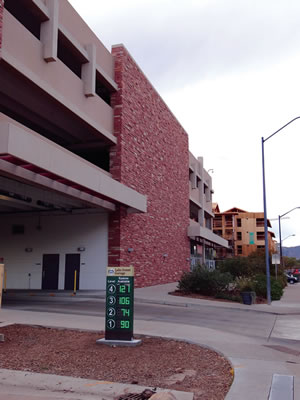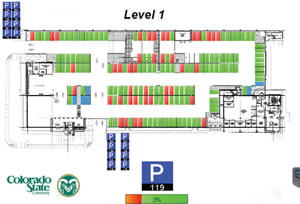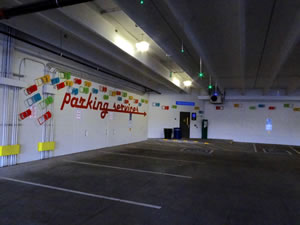Smart Parking

PHOTOS COURTESY OF COLORADO STATE UNIVERSITY
Sustainability is priority
for many colleges and universities,
but at Colorado State University
(CSU) it’s woven into the school’s DNA. The
“greening” of CSU has been happening since
the campus’ first farm opened in 1888. Since
then, generation after generation of CSU administrators,
staff and students have dedicated
themselves to sustainability through
classroom programming, research projects,
research laboratories and off-campus initiatives.
The university’s dedication to being a
green leader led BestColleges.com to name
CSU America’s Greenest University for 2015,
and it recently became the first school in
the world to receive the Platinum Rating by
the AASHE STARS program (stars.aashe.org).
The Role of
Alternative Transportation
One of the keystones of CSU greener
campus program is its commitment to
alternative transportation. Nearly half of
the school’s faculty, staff and students use
alternative forms of transportation to get
to the Fort Collins-based campus each
day, including carpooling, biking, walking
or taking the bus. Of course, Colorado is
well known as a wonderland for outdoor
enthusiasts. Given that reputation, it’s no
surprise that bicycles are a popular form
of transportation on campus. CSU offers
numerous paths and resources for bicycle
commuters, including a new bike fix-it station,
offering repairs to bicyclists.
CSU also offers carpooling through
its Ridesharing program, which connects
riders online with other students and/or staff for rides to campus, ski trips, and
recurring trips and entertainment rides,
such as concerts and sporting events. Not
everyone’s schedule permits ride-sharing,
though, so the campus has also partnered
with Zipcar, Inc., to offer a car-sharing
program on-campus. For students with a
temporary need for a vehicle, the Zipcar
program is available 24/7.
As is the case with most urban universities,
bus service plays an important
role in the overall campus transportation
program. CSU partners with the City of
Fort Collins to provide bus service between
the city and the university campus.

ILLUSTRATION COURTESY OF COLORADO STATE UNIVERSITY
RED LIGHT, GREEN LIGHT. Colorado State University in Fort Collins recently installed a
parking guidance system that uses lighted sensors to guide parkers to available spaces
within the garage. Green lights indicate a space is available, red lights indicate a space is
occupied. Also provided are blue lights for handicapped parking and purple for charging
stations for electric vehicles. A web-based operating system and mobile apps can also be
included with the system, providing real-time data. The web-based component can be programmed
to adjust lighting and exhaust fans within a structure, reducing operating costs.
A New Approach:
Greener Parking
But what sets CSU apart is the university’s
unique approach to promoting sustainability
through its parking program. Sustainable parking is nothing new. For
more than a decade parking designers
have been working sustainable elements
like solar panels, green roofs and walls
and centrally located light cores into their
designs. CSU recently broke new ground,
however, by installing a cutting edge parking
technology — a sensor-based parking
guidance system — in the university’s LEED-certified garage as their latest green
parking initiative. Single-spaced sensors
are the hottest new technology in a parking
industry that’s currently being transformed
by technological advancement.
CSU’s new parking guidance system
features the installation of parking sensors
in each of the 645 covered spaces and
monitors all 870 spaces in the university’s
only parking structure. A space indicator
light is installed on a dropper at the front of
the parking space, offering drivers a clear
view of where open spaces can be found
and what type of parking is permitted
in an individual space. Different colors
indicate each space’s status and user group:
green for available, red for occupied, blue
for handicapped parking and purple for
electric vehicle charging stations. The
lights are clearly visible to drivers when
they enter each level so they can quickly
determine if a space is available on that
floor. A monument-style sign is installed at
each of the garage entries to advise customers
where parking is available as they
approach the garage. Because the sensors
constantly update the system, the information
is provided to drivers in real time and
is always current.
Parking guidance sensors were developed
as a customer-service amenity and
management tool, but CSU’s parking planners
recognized their promise for promoting
sustainability as well.
“By guiding parkers directly to open
spaces, the parking guidance system minimizes
the amount of time spent searching
for parking,” says Doug Mayhew, Colorado
State University’s associate director of
Parking and Transportation. “As a result,
it decreases the amount of vehicle exhaust
emitted in the structure and reduces the
amount of unnecessary fuel wastage.
“By reducing exhaust we are also protecting
the health of our students, faculty
and staff,” adds Mayhew.
It may be tempting to view the sensor
program as more of a symbolic effort,
but Mayhew says it’s anything but that.
“Since we installed the sensors last fall, the
response from our students and staff has
been overwhelmingly positive.”
CSU chose INDECT’s ultrasonic sensors.
“There’s no point in installing sensors
in our parking facility if we aren’t sure that
they are going to be accurate and reliable,”
said Mayhew. “We did extensive research
studying all of the options available to us.”
According to Dale Fowler, director of
INDECT USA, in addition to promoting
sustainability, the CSU sensor program will
also provide additional benefits.
“CSU’s parking program demonstrates
the versatility of single-space sensors,” says Fowler. “Sensors are well known throughout the parking industry
for the parker convenience and management benefits they provide,
but the sustainability advantages are just as important.”

PHOTOS COURTESY OF COLORADO STATE UNIVERSITY
According to Fowler, the parker convenience benefits are
obvious. By guiding drivers directly to open spaces, the system
eliminates the frustration of having to drive throughout the garage
looking for an open space and can significantly reduce the amount
of time it takes to find parking. The system also provides a safer
parking environment because the risk of accidents or collisions
with pedestrians is significantly reduced when parkers spend less
time driving throughout the garage. In addition to enhancing
safety, this also reduces the university’s liability.
Finally, by reducing wear and tear on the parking structure, the
sensors can save the university thousands of dollars in maintenance
and repair costs and extend the useful life of the garage.
“The sensor program also allows university planners to make
more informed policy and planning decisions,” says Fowler. “The
sensors collect data about length of stay, occupancy and usage for
each of the different user groups at the garage. University planners
will be able to use that data to enhance its parking policies and
procedures.”
CSU’s Mayhew appreciates the versatility of the sensors.
“Our principal objective in initiating this program was
twofold, to promote sustainability and to make campus parking
more convenient and manageable,” says Mayhew. “We are also
pleased that the [parking sensor] system has accomplished both
objectives.”
The program has been so successful that as the university
expands its parking resources, the sensors will continue to play an
important role. CSU is currently developing a second garage that is
slated to open this August, and that facility will also be equipped
with ultrasonic sensors.
This article originally appeared in the issue of .